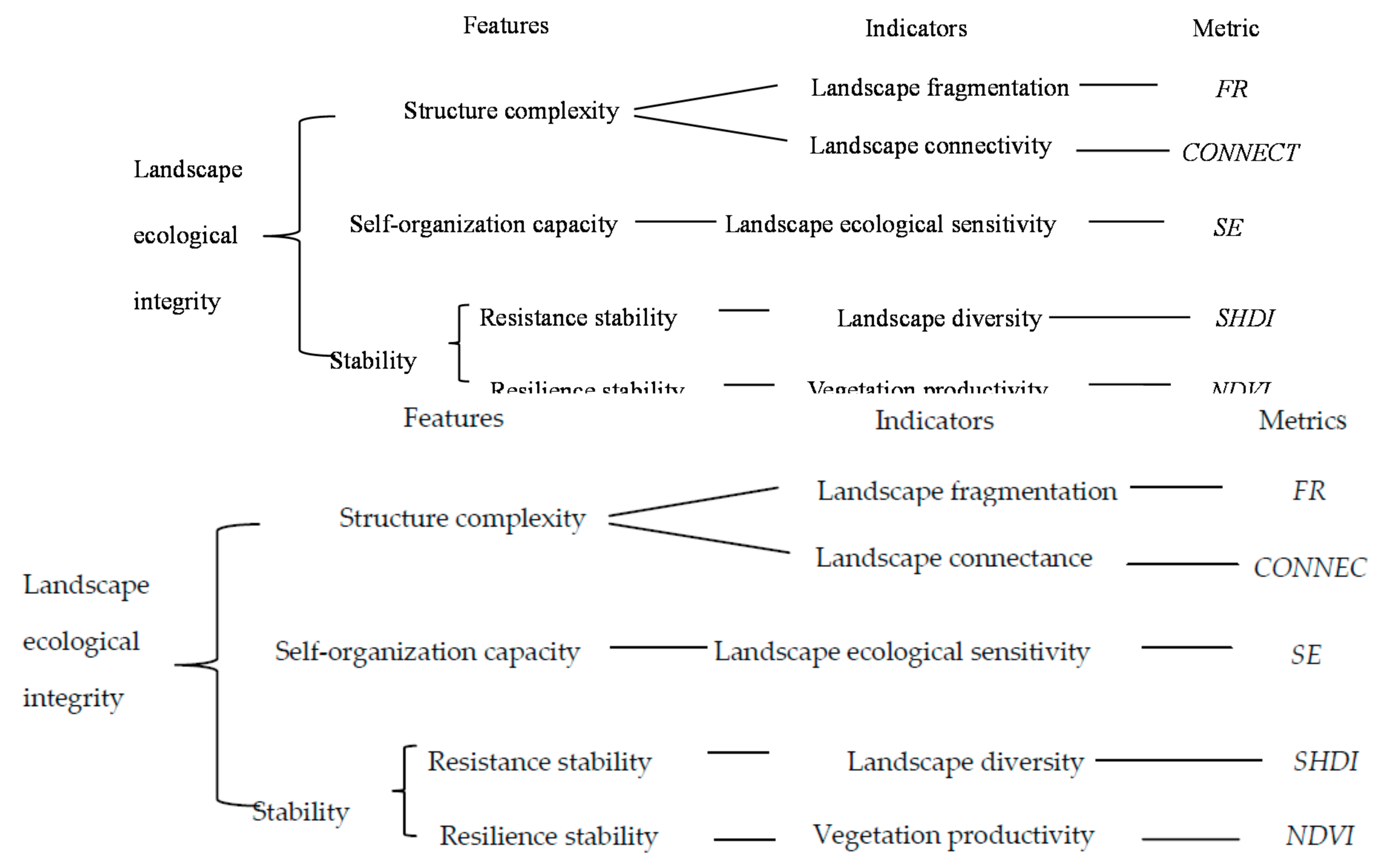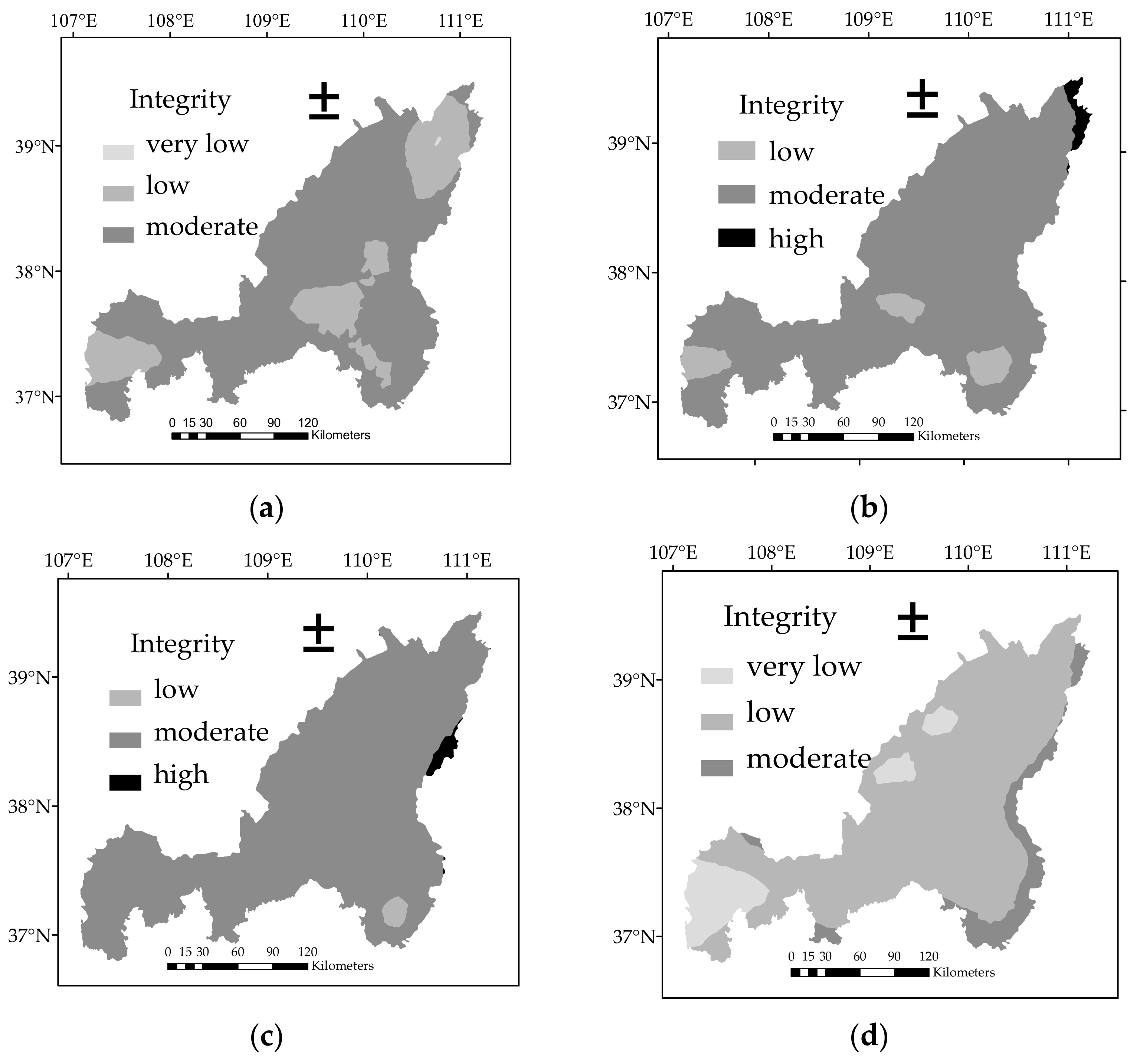Evaluation of Landscape Ecological Integrity in the Yulin Region, China
Abstract
:1. Introduction
2. Materials and Methods
2.1. Framework for Evaluation of Landscape Ecological Integrity
2.2. Study Area
2.3. Data Acquisition and Pre-Processing
2.4. Model to Evaluate the LEI
3. Results
4. Discussion
4.1. Landscape Fragmentation Index
4.2. The Landscape Ecological Integrity of the Yulin Region
5. Conclusions
Author Contributions
Funding
Conflicts of Interest
References
- Reza, M.I.H. Importance and Considerations for the development of a composite Index of Ecological Integrity for ecological management. Int. J. Ecol. Dev. 2014, 28, 33–48. [Google Scholar]
- Fraser, R.H.; Olthof, I.; Pouliot, D. Monitoring land cover change and ecological integrity in Canada’s national parks. Remote Sens. Environ. 2009, 113, 1397–1409. [Google Scholar] [CrossRef]
- Parrish, J.D.; Braun, D.P.; Unnasch, R.S. Are We Conserving What We Say We Are? Measuring Ecological Integrity within Protected Areas. BioScience 2003, 53, 851–860. [Google Scholar] [CrossRef]
- Theobald, D.M. A general model to quantify ecological integrity. Landsc. Ecol. 2013, 1859–1874. [Google Scholar] [CrossRef]
- Heckmann, K.E.; Manley, P.N.; Schlesinger, M.D. Ecological integrity of remnant montane forests along an urban gradient in the Sierra Nevada. For. Ecol. Manag. 2008, 255, 2453–2466. [Google Scholar] [CrossRef]
- Reza, M.I.H.; Abdullah, S.A. Regional Index of Ecological Integrity: A need for sustainable management of natural resources. Ecol. Indic. 2011, 11, 220–229. [Google Scholar] [CrossRef]
- Karr, J.R. Ecological integrity and ecological health are not the same. In Engineering within Ecological Constraints; Schultze, P., Ed.; National Academy of Science: Washington, DC, USA, 1996. [Google Scholar]
- Zampella, R.A.; Bunnell, J.F.; Laidig, K.J.; Procopio, N.A. Using multiple indicators to evaluate the ecological integrity of a coastal plain stream system. Ecol. Indic. 2006, 6, 644–663. [Google Scholar] [CrossRef]
- Andreasen, J.K.; O’Neill, R.V.; Noss, R.; Slosser, N.C. Considerations for the development of a terrestrial index of ecological integrity. Ecol. Indic. 2001, 1, 21–35. [Google Scholar] [CrossRef] [Green Version]
- Ramesh, S.; Kaplana, K. Ecological integrity and environmental protection for Vijayawada region—Scattered Eastern Ghats. Int. J. Sustain. Built Environ. 2015, 4, 109–116. [Google Scholar] [CrossRef]
- DeKeyser, E.S.; Kirby, D.R.; Ell, M.J. An index of plant community integrity: Development of the methodology for assessing prairie wetland plant communities. Ecol. Indic. 2003, 3, 119–133. [Google Scholar] [CrossRef]
- Hargiss, C.L.M.; DeKeyser, E.S.; Kirby, D.R.; Ell, M.J. Regional assessment of wetland plant communities using the index of plant community integrity. Ecol. Indic. 2008, 8, 303–307. [Google Scholar] [CrossRef]
- Hughes, J.E.; Deegan, L.A.; Weaver, M.J.; Costa, J.E. Regional application of an index of estuarine biotic integrity based on fish communities. Estuaries 2002, 25, 250–263. [Google Scholar] [CrossRef]
- Solimini, A.G.; Bazzanti, M.; Ruggiero, A.; Carchini, G. Developing a multrimetric index ofecological integrity based on macroinvertebrates of mountain ponds in central Italy. Hydrobiologia 2008, 597, 109–123. [Google Scholar] [CrossRef]
- Angermeier, P.L.; Davideanu, G. Using fish community to assess streams in Romania: Initial development of an index of biotic integrity. Hydrobiologia 2004, 511, 65–78. [Google Scholar] [CrossRef]
- Ortega, M.; Velasco, J.; Millan, A.; Guerrero, C. An ecological index for littoral wetlands in agricultural catchments of semiarid Mediterranean regions. Environ. Manag. 2004, 33, 412–430. [Google Scholar] [CrossRef] [PubMed]
- Ordóñez, C.; Duinker, P.N. Ecological integrity in urban forests. Urban Ecosyst. 2012, 15, 863–877. [Google Scholar] [CrossRef]
- Müller, F. Indicating ecosystem and landscape organisation. Ecol. Indic. 2005, 5, 280–294. [Google Scholar] [CrossRef]
- Matisziw, T.C.; Murray, A.T. Connectance change in habitat networks. Landsc. Ecol. 2009, 24, 89–100. [Google Scholar] [CrossRef]
- Luque, S.; Saura, S.; Fortin, M.-J. Landscape connectance analysis for conservation: Insights from combining new methods with ecological and genetic data. Landsc. Ecol. 2012, 27, 153–157. [Google Scholar] [CrossRef]
- Stevens, F.; Bogaert, P.; van Wesemael, B. Detecting and quantifying field-related spatial variation of soil organic carbon using mixed-effect models and airborne imagery. Geoderma 2015, 259–260, 93–103. [Google Scholar] [CrossRef]
- Folke, C.; Carpenter, S.; Walker, B.; Scheffer, M.; Elmqvist, T.; Gunderson, L.; Holling, C.S. Regime sifts reslilience and biodiversity in ecosysytem management. Annu. Rev. Ecol. Evol. Syst. 2004, 35, 557–581. [Google Scholar] [CrossRef]
- Pettorelli, N.; Vik, J.O.; Mysterud, A.; Gaillard, J.M.; Tucker, C.J.; Stenseth, N.C. Using the satellite-derived NDVI to assess ecological responses to environmental change. Trends Ecol. Evol. 2005, 20, 503–510. [Google Scholar] [CrossRef] [PubMed]
- Reed, B.C.; Brown, J.F.; VanderZee, D.; Loveland, T.R.; Merchant, J.W.; Ohlen, D.O. Measuring phenological variability from satellite imagery. J. Veg. Sci. 1994, 5, 703–714. [Google Scholar] [CrossRef]
- Baldi, G.; Nosetto, M.D.; Aragón, R.; Aversa, F.; Paruelo, J.M.; Jobbágy, E.G. Long-term Satellite NDVI Data Sets: Evaluating Their Ability to Detect Ecosystem Functional Changes in South America. Sensors 2008, 8, 5397–5425. [Google Scholar] [CrossRef] [PubMed] [Green Version]
- Loreau, M.; Mazancourt, C.D. Biodiversity and ecosystem stability: A synthesis of underlying mechanisms. Ecol. Lett. 2013, 16 (Suppl. S1), 106–115. [Google Scholar] [CrossRef] [PubMed]
- Nagendra, H. Opposite trends in response for the Shannon and Simpson indices of landscape diversity. Appl. Geogr. 2002, 22, 175–186. [Google Scholar] [CrossRef]
- Shi, Y.; Li, T.; Shi, X.; Kang, H.; Yan, Y. Spatial-temporal characteristics of landscape ecological sensitivity in Yulin area. Remote Sens. Land Resour. 2017, 29, 167–172. (In Chinese) [Google Scholar]
- Song, F.; Xing, K.; Liu, Y.; Liu, Z.C.; Kang, M.Y. Monitoring and assessment of vegetation variation in northern Shaanxi based on MODIS/NDVI. Acta Ecol. Sin. 2011, 31, 354–363. (In Chinese) [Google Scholar]
- Bai, J.; Bai, J.; Wang, L. Spatio-temporal change of vegetation NDVI and its relations with regional climate in northern Shaanxi province in 2000–2010. Sci. Geogr. Sin. 2014, 34, 882–888. (In Chinese) [Google Scholar]
- Zheng, J.; Sun, H. Analysis of Characteristics of Precipitation in Yulin Area of Shaanxi Province. Acta Agric. Jiangxi 2015, 27, 94–98. (In Chinese) [Google Scholar]
- Zhang, X. The utilization of water resource of Yulin. Shaanxi Water Resour. 2015, 6, 117–120. (In Chinese) [Google Scholar]




| Sensitivity Class | Soil Texture | Terrain Undulation (m) | Vegetation or Land Use |
|---|---|---|---|
| 1 Insensitive | Clay loam | 0–20 | Water, paddy field, marsh |
| 2 Mild | Gravel loam, sandy loam clay | 20–50 | High coverage grassland, forest land |
| 3 Moderate | Loam | 51–100 | Moderate and low coverage grassland, saline alkali land |
| 4 High | Sandy loam | 101–300 | Sand land, farmland |
| 5 Extreme | Sandy soil | >300 | Bare, mining and industry, built land |
| Sensitivity Class | Land Use and Land Cover | Weight |
|---|---|---|
| 1 Insensitive | Forest, high coverage grassland, water | 0.05 |
| 2 Mild | Moderate coverage grassland, urban and residential land | 0.10 |
| 3 Moderate | Saline alkali land, land for mining and industry, farmland | 0.20 |
| 4 High | Bare land, low coverage grassland | 0.25 |
| 5 Extreme | Sand | 0.40 |
| Year | Very Low | Low | Moderate | High | Total |
|---|---|---|---|---|---|
| 2000 | 0.052 | 20.882 | 79.066 | 0 | 100 |
| 2005 | 0.0 | 5.947 | 92.615 | 1.438 | 100 |
| 2010 | 0.0 | 1.000 | 97.951 | 1.049 | 100 |
| 2015 | 10.381 | 80.390 | 9.229 | 0 | 100 |
| 2000 | 2005 | 2010 | 2015 | |
|---|---|---|---|---|
| Raw coal | 3125.0 | 6560.3 | 25,732 | 36,103.5 |
| Crude oil | 89.0 | 476.4 | 983 | 1186.94 |
| Crude salt | 7.5 | 26.3 | 40.98 | 134.8 |
| Washed coal | _ | _ | _ | 7053.05 |
| Fine methanol | _ | 46.88 | 119.86 | 222.07 |
| Polyvinyl chloride | _ | _ | 16.41 | 131.36 |
| Semi-coke | _ | _ | 959.56 | 2499.11 |
| Gas (×108 m3) | 34 | 60.5 | 109.86 | 151.13 |
| Electric energy (×108 kwh) | _ | 68.45 | 356.96 | 629.34 |
© 2018 by the authors. Licensee MDPI, Basel, Switzerland. This article is an open access article distributed under the terms and conditions of the Creative Commons Attribution (CC BY) license (http://creativecommons.org/licenses/by/4.0/).
Share and Cite
Shi, Y.; Wang, N.; Li, T.; Wang, H.; Kang, H.; Shi, X. Evaluation of Landscape Ecological Integrity in the Yulin Region, China. Sustainability 2018, 10, 4300. https://doi.org/10.3390/su10114300
Shi Y, Wang N, Li T, Wang H, Kang H, Shi X. Evaluation of Landscape Ecological Integrity in the Yulin Region, China. Sustainability. 2018; 10(11):4300. https://doi.org/10.3390/su10114300
Chicago/Turabian StyleShi, Yuqiong, Ninglian Wang, Tuansheng Li, Han Wang, Huanhuan Kang, and Xiaohui Shi. 2018. "Evaluation of Landscape Ecological Integrity in the Yulin Region, China" Sustainability 10, no. 11: 4300. https://doi.org/10.3390/su10114300




